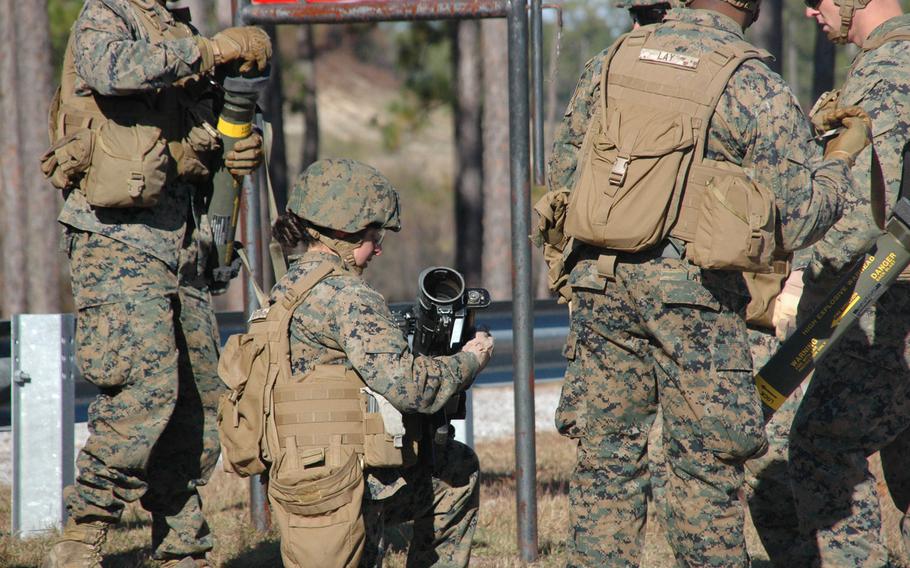
A female Marine assembles a rocket launcher at Camp Lejeune, N.C. (Jon Harper/Stars and Stripes)
CAMP LEJEUNE, N.C. — Secretary of Defense Chuck Hagel believes women have the right to serve in direct ground combat units if they meet physical requirements, and he made clear that he views lifting gender-based exclusions as a civil rights issue.
During a talk with Marines at Camp Lejeune, N.C., on Tuesday, Hagel met with female Marines participating in training to see how well women can perform combat tasks within gender-integrated units.
The evaluations will help determine which combat specialties will open to women in the wake of last year’s decision by Hagel’s predecessor to rescind the blanket ban on women serving in direct ground combat units.
“The integration of our services... is important,” Hagel said. “We are a country that believes ... that every individual deserves the same opportunities if you’re capable ... and can do the job.”
He noted that individuals who weren’t white and male were long unfairly denied their rights and opportunities, but American society has changed.
He said giving people a chance to succeed and maximize their talents is “the right thing to do.”
Some inside and outside the military and outside oppose opening up combat roles to women due to concerns they won’t be up to the task and it will harm unit cohesion.
Hagel acknowledged the challenges ahead.
“I know it is not easy. I know we are dealing with cultural issues,” he said.
But he noted the military has successfully integrated other excluded groups.
In 2010, the ban on gays and lesbians serving openly in the military was repealed. In 1948, President Harry Truman banned racial segregation in the armed forces. Both were controversial at the time.
Hagel is familiar with the challenges and culture of the combat arms. He served as an Army infantryman in Vietnam and received two Purple Hearts after being wounded in action.
“Cultures are important … and a culture has to be factored into” policy decisions, Hagel said. But “everyone deserves an opportunity to succeed and do whatever he or she believes they are capable of doing. It doesn’t mean we change [performance] standards, but it does mean that we open up new opportunities for all of our people… And that’s what we’re doing here.”
Evaluating performance
The Marine Corps’ Ground Combat Element Integrated Task Force at Camp Lejeune is being used to assess the implications of gender integration and gather data about the performance of female troops.
About 100 female and 550 male Marines will be part of the task force when it gets up to full manning levels. During the intensive 16-week evaluation course, which runs from October 2014 to February 2015, women are performing the same tactical tasks as their male counterparts in combat specialties like infantry, artillery and armor.
Cpl. Raquel Mathieu said it’s been more difficult for the men in her provisional infantry unit to adjust because the female Marines already served in mixed-gender support units.
“It took a little bit of time for them to get to know how to work with females,” she said.
But she said the male Marines have been supportive.
“In my platoon [no one ever said], ‘Females can’t do this, females can’t do that.’ We were always encouraging everybody to do the same thing,” she said. “The males help push the females along.”
Col. Matthew St. Clair, the commander of the GCEITF, said things are going well.
“I’m very pleased with where we are right now,” he told reporters.
But it’s too soon to compare GCEITF units’ performance to all-male combat units, St. Clair said, because they have only been together a few weeks, and the female Marines come in at a major disadvantage. Most of the male Marines in the GCEITF have been in their combat military occupational specialties for two or three years, whereas the females have only had basic levels of specialty training.
He said the biggest challenge is to “get them all on kind of the same playing field so that they all have a baseline level of proficiency and efficiency in the different occupations in which they’re serving.”
After they finish the training at Lejeune, the men and women of the GCEITF will go to other training bases for the final phase of evaluation.
Changing the policy
The services, under orders to integrate women into new positions and units no later than Jan. 1, 2016, are conducting assessments to develop, review and validate gender-neutral individual occupational specialty standards. To keep an occupational specialty or unit closed to women, the services must make a case based on the evaluations and get the secretary of defense’s approval.
There has been speculation that the Marine Corps and the other services will ask the secretary to keep special operations forces all-male.
“We’re not presupposing” that any occupational specialties need to remain closed, said a Marine Corps official who briefed reporters about the process on condition of anonymity. “We’re going to go where the data [from the assessments] takes us.”
Hagel did not say whether he would be amenable to barring women from certain combat jobs. But his remarks suggested the justification bar will be high to keep any doors shut.
Twitter: @JHarperStripes